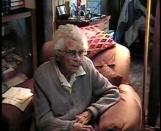14
Life went on despite the losses. The Alberta Provincial Police took over law enforcement duties here as elsewhere following the establishment of the force in 1917. However, Fort Saskatchewan rated just one officer, who was housed on the main floor of the local courthouse.15
This was lost when the Alberta Provincial Police was disbanded and the Royal Canadian Mounted Police returned to the province in 1932. The mounted police chose to open a station in Lamont instead, leaving Fort Saskatchewan without a professional police force.16
A municipal police force did exist. The first act of the first town council had been to appoint a town constable, Mr. Joe Chabot on July 23, 1904. But he was not a trained police officer, and the force remained at just one man for many years to come.17
The Curfew Bell19
The duties of the municipal constable were many, according to Fort resident Mary Mager, who remembers how things were when she arrived in town in 1921 at the age of eight.21
"We noticed there was a police force in town. The night policemen were responsible for ringing the curfew bell at 9 o'clock and the bell was in the fire hall where the town office was situated."23
Mary Mager goes on to say that she felt Fort Saskatchewan was a big town when she arrived, having lived in little Athabasca Landing before that.Fort Saskatchewan had concrete sidewalks on downtown streets, and cinder paths elsewhere. The roads were just dirt, but the school was a big, impressive brick building.
The town also had electric power supplied to most homes. The power came from a generator in the basement of the Gaol, and was only on for a few hours each evening.
24
The population of Fort Saskatchewan remained at about 1,000 people throughout the period between the wars.But many other changes came about, Mary Mager says. Horses were replaced by cars and trucks, and electricity, radios and telephones became more commonplace.

